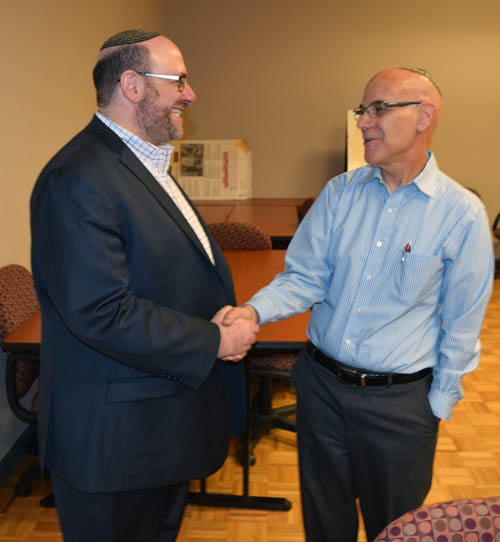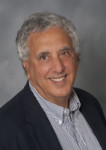
By Donald H. Harrison

SAN DIEGO – If the Shabbat services at your synagogue are not well attended, then you should ask five questions in reexamining how they are conducted, according to Rabbi Steven Wernick, chief executive officer of the United Synagogue of Conservative Judaism.
Wernick served as scholar in residence Jan. 22-23 at Congregation Beth Am, and also had meetings at other area synagogues including Congregation Beth El and Tifereth Israel Synagogue.
At the latter synagogue, Wernick met with a group of leaders including Rabbi Leonard Rosenthal and members drawn from Tifereth Israel’s Board of Directors, Sisterhood, and Men’s Club.
One of the first questions to be asked concerns the role of the Hebrew language in the service, Wernick said. How well do members of the congregation understand Hebrew? If they don’t understand it well, there can be a greater emphasis on teaching Hebrew. Or, another approach could be to deemphasize Hebrew and have more English in the service. You can make sure that there are good translations for every prayer, as well as readable transliterations.
“You have to ask the question ‘What is the place of Hebrew in the modern religious experience?’” he said. “We, as Conservative Jews place it pretty high up because we understand that there are certain core words that don’t translate. Tzedakah is an example. Tzedakah is not ‘charity,’ it is ‘righteousness,’ whereas ‘charity’—caritas—is ’empathy.’”
Wernick said a second question that congregations must ask themselves is “What is the theology of our prayer service and how do we express it in the rhythm of the prayer service we are providing?”
Although every congregation will answer the five questions about prayer differently, Wernick said, he believes that “synagogues exist in order to help Jews transform their own experience, refine the human condition, and therefore impact the world through them. We have a moral vision and we have a proven methodology about how that vision gets expressed in the world through action, learning, prayer and social justice work. If we don’t start with that, if our boards are not really committed to a vision of Judaism that has the capacity to transform the human experience, then you are never going to have enough members to keep the lights on.”
A third question concerning Shabbat services deals with music, Wernick said. “Music is critically important and that is not just musical instrumentation. We know that singing is the language of the heart. What is the music? Who is responsible for the music? What is the balance between the congregational melodies versus more traditional chazanut (traditional prayers sung by cantors)?”
In an aside, Wernick asked why it is that ‘Adon Olam,’ which many congregations sing at the conclusion of their prayer services, can be sung to every melody? He answered that it is “because it is in a 4/4 beat that also is the rhythm of the heart beating, the rhythm of the water hitting the sea shore, the rhythm of a horse galloping, and, I learned recently, it is also the gait of a human being with healthy hips. So is it a coincidence that a poem entitled ‘Adon Olam’ (Master of the Universe) is also written to the rhythm of the universe? The last thing we say in that (eg, the concluding verse) is that ‘God is with me, and I am not afraid.’ As if to say the whole purpose of being in shul is that God is with me and I am not afraid. When I finish this spiritual experience and I go out into the world…I feel something…I am not alone…I am part of a great tradition, a great community. I have a connection to God.’”
A fourth question, said Wernick, deals with the timing of the services. “Should it be at 6 o’clock Friday nights, at 8 o’clock, 7:30 p.m., or 5 p.m. Each choice has consequences. How long is Shabbos morning?”
The fifth question, he said, considers the demographic make up of each synagogue. “Who is the target audience? Is it multi-generational? Maybe one size does not fit all.” Maybe, in other words, alternative services for different age groups should be considered.
The rabbi began and ended his meeting at Tifereth Israel Synagogue talking about Bennett Decker, a 17-year-old Jewish student who went on a trip to Poland and Israel under auspices of the United Synagogue of Conservative Judaism. Following a Kabbalat Shabbat service in Jerusalem, he and the rabbi walked up a hill together to the place where Shabbat dinner would be served. Rabbi Wernick asked the young man what he was feeling.
Decker reflected that only a few days before he had been in Majdanek, a concentration camp that the German Nazis had built in Poland. In a deep pit capped by a dome are stored the ashes of people who were cremated there. Wernick paraphrased Decker as telling him: “A wind comes up and the ashes start to dance a little it in the wind, and you can smell it. I am realizing in some way, shape or form, I am inhaling the life force of these Jews and other people who perished at the hands of the Nazis. And what I am thinking about is that here I am four days later in Jerusalem, in the new city of Jerusalem, overlooking the old city, davening Kabbalat Shabbat and what I am doing is exhaling. What I am thinking about is how I have become this vessel for the life force of those who perished, whose lives were cut short, and I am fulfilling the dream of those who were there.”
Wernick said that Decker then drew an analogy to the verse near the end of Genesis when Jacob asks his children to be sure to remove his body from Egypt and to rebury it in the Promised Land, a request fulfilled many years later by Moses. Again paraphrasing Decker, Wernick said “So I find that I am like Moshe. Here we are in the modern state of Israel, and I am carrying Jacob’s bones with me.”
The rabbi noted that Decker was not a day school student. He attended secular schools supplemented by membership in United Synagogue Youth and by Camp Ramah summer experiences. Decker’s story, Wernick added, “is everything that we are about. The mission of the Jewish people is to be vessels of holiness in time and space. In order for a kid like Bennett to construct that line of meaning and reasoning, you have to know something, you’ve got to be able to do something, and you have to be in a community of peers and adults that are thinking with kavanah to create those moments.”
*
Harrison is editor of San Diego Jewish World. He may be contacted via donald.harrison@sdjewishworld.com. Comments intended for publication in the space below must be accompanied by the letter writer’s first and last name and by his/ her city and state of residence (city and country for those outside the U.S.)
Pingback: 5 questions to ask about Shabbat services | The Ruach
Rabbi Wernick stated (at Congregation Beth Am) that summer camping programs have been one of the biggest successes of the Conservative movement. Why not create more of a bridge between what our youth are experiencing at camp and what is happening at their local shuls? I’m not referring to the “lake effect.” In other words, I’m not implying that the synagogues replicate camp, but I am suggesting that they find out what really inspires and ignites people, and go from there. That said, I also acknowledge that most synagogues send out periodic surveys, have meetings, and make phone calls, but that’s probably not enough. More face-to-face conversations and improved dialogue would certainly help.
–Diana Lerner, San Diego